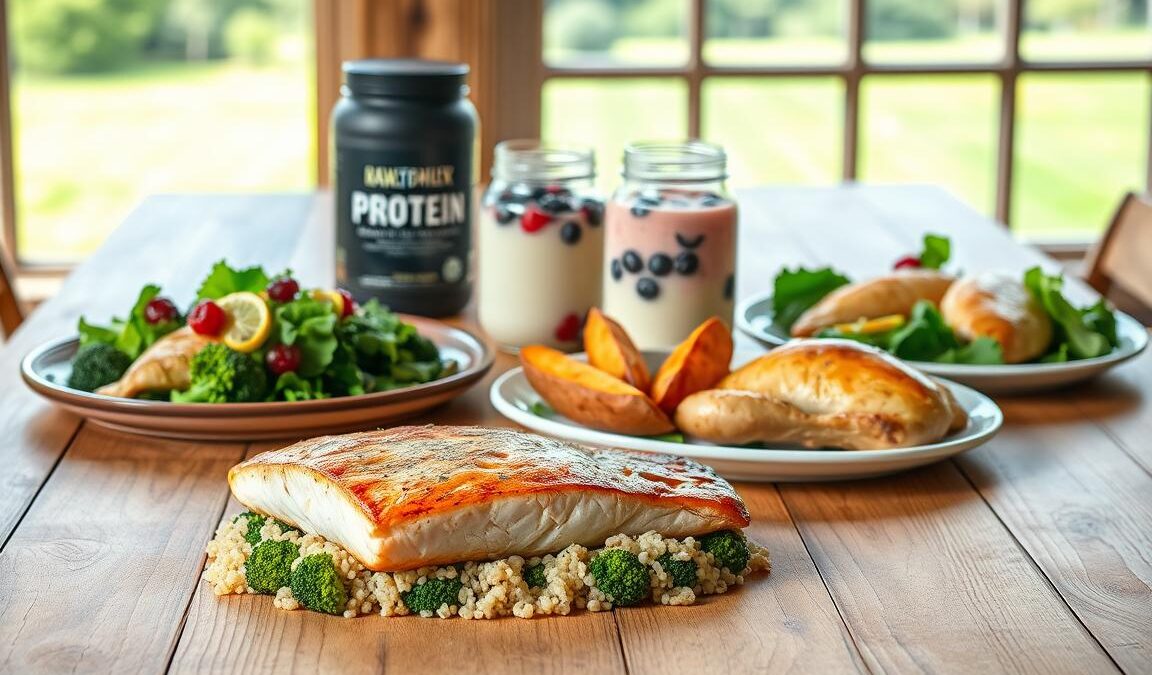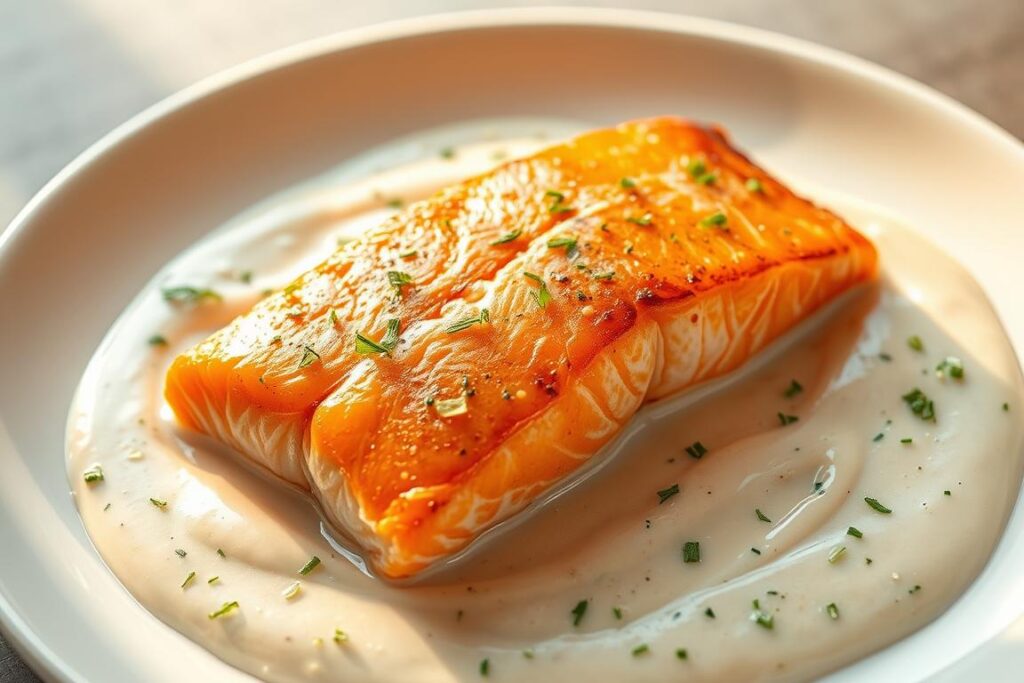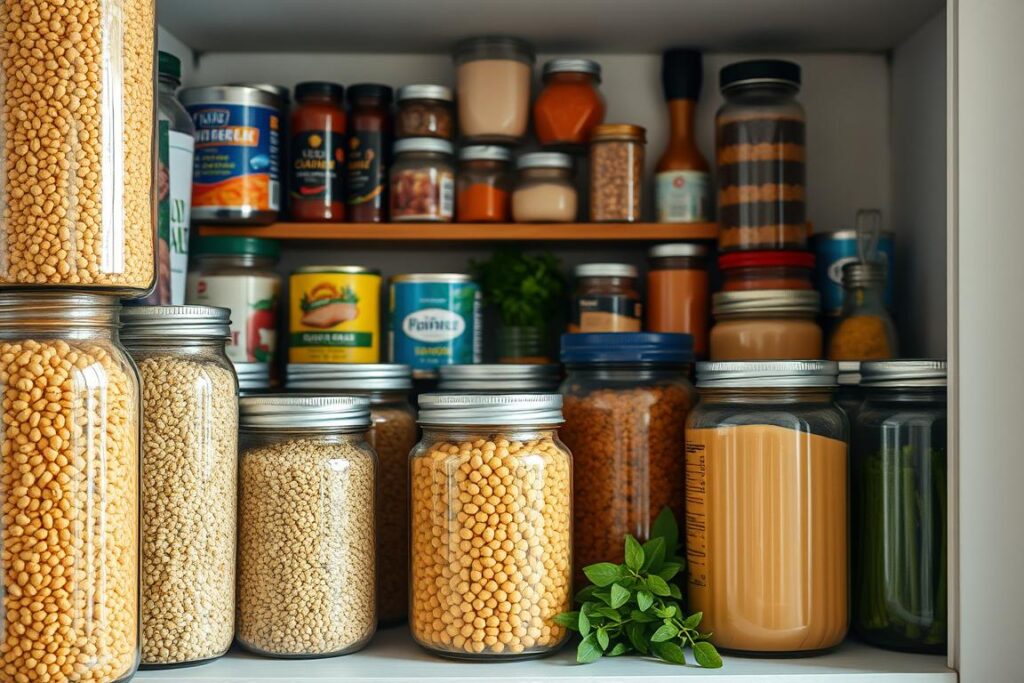
Low‑Sodium High‑Protein Meals for Healthy Muscle Gain
Want meals that build muscle without stressing your heart? Picture juicy grilled fish, bright herbs, and a plate that repairs muscle while keeping your blood pressure steady. You’ll get clear, science-backed swaps that boost protein and cut excess salt so recovery feels reliable and tasty.
Start with lean cuts and seafood to raise protein density and limit unnecessary fat. Aim for portion targets per serving so you meet your daily grams without guessing. Use acids, spices, and aromatics to replace table salt and keep flavor vivid.
How it helps: proper protein supports repair and growth, while mindful sodium choices protect heart and fluid balance. You’ll leave this section with quick-cook ideas and smart label tips to make these swaps practical for weeknights and batch cooks.
Key Takeaways
- Focus on the phrase “low sodium high protein meals” to guide your plate choices.
- Choose lean proteins and seafood to increase protein per serving with less fat.
- Replace salt with herbs, citrus, and vinegar for big flavor gains.
- Watch sodium on labels and aim for portions that meet daily goals.
- Balanced choices support muscle strength and cardiovascular health.
Why low sodium plus high protein is a smart combo for muscle and heart health
Want a simple rule to protect your heart while you build muscle? Keep an eye on salt and hit steady protein targets each day. Small choices per plate add up.
What counts as a sensible sodium target? Aim for about 300–600 mg per serving at dinner. That keeps your daily intake near the 2,300 mg guideline, or closer to 1,500 mg if you have hypertension or kidney concerns.
How much protein do you need? For active people, start at 1.2–2.0 g/kg/day (0.54–0.9 g/lb). Spread this across meals so each serving gives roughly 25–40 g to support muscle repair.
- Use labels and recipe nutrition to check per-serving salt and portion size.
- Pick lean options to limit saturated fat while meeting your grams.
- Pair protein with vegetables and whole grains to add potassium and magnesium.
| Target | Per Serving | Daily Goal | Practical Tip |
|---|---|---|---|
| Salt | 300–600 mg | 1,500–2,300 mg | Check “per serving” on recipes and labels |
| Protein | 25–40 g | 1.2–2.0 g/kg body weight | Distribute across 3–5 meals for steady synthesis |
| Fat | Keep saturated fat low | Moderate overall intake | Choose lean cuts and healthy oils |
| Recovery | Meal + snack strategy | Track weekly totals | Prioritize consistency over perfection |
Simple rules to keep flavor high and sodium low
You can amp flavor and cut salt at the same time with a few chef-tested tricks. Start with acids and aromatics to make each bite ring true. Keep the approach practical so you can act tonight.
Salt swaps: citrus, garlic, herbs, and warm spices for bold taste
Swap added salt for acid first. Lemon, lime, and vinegar brighten food and lift aromas without added sodium.
Build base flavor with garlic, onion, and fresh herbs. Finish with zest or a splash of vinegar for a bright pop.
- Layer warm spices—cumin, paprika, coriander—for depth and gentle heat.
- Use salt-free blends like chili-lime or Italian herb to season generously.
- Finish with olive oil, chopped herbs, or toasted nuts to add richness instead of salt.
Reading labels and choosing “no‑salt‑added” ingredients
Compare nutrition facts across brands. Two similar items can differ by hundreds of milligrams of sodium.
Choose no‑salt‑added canned fish, tomatoes, and beans when possible. A 3‑oz can of salt-free salmon has about 63.8 mg sodium and 17.4 g protein versus ~342 mg for salted versions.
- Rinse canned beans and vegetables to remove surface sodium.
- Swap salt-heavy dairy for plain Greek yogurt or whipped ricotta for creamy texture and controlled sodium.
| Swap | Why it works | Example | Quick tip |
|---|---|---|---|
| Salt → Lemon/Vinegar | Brightens and enhances aroma | Grilled fish with lemon zest | Add acid at the end for lift |
| Salt → Herbs & Garlic | Builds savory base without sodium | Herbed cottage cheese bowl | Use fresh herbs and minced garlic |
| Salt → Warm spices | Adds depth and complexity | Cumin‑paprika chicken rub | Toast spices briefly to boost aroma |
| Standard cans → No‑salt‑added | Cut sodium dramatically, keep protein | Salt‑free canned salmon or beans | Compare labels; rinse if needed |
Low sodium high protein meals: quick wins you can cook tonight
Looking for easy recipes that deliver strong nutrition and minimal cleanup?
Here are three fast, flavorful options you can finish in about 30 minutes.
Sheet‑pan lemon‑garlic salmon with tomatoes and olives
Why choose a sheet‑pan? You get a high-protein dinner with almost no cleanup.
Arrange skin-on salmon, cherry tomatoes, and olives on a tray. Drizzle with olive oil, minced garlic, lemon slices, and cracked pepper. Roast until the salmon flakes and the tomatoes burst. The juices form a light pan sauce—serve over a whole grain for fiber.
One‑pan chicken and asparagus bake — family friendly
Pound chicken to even thickness for quick, juicy cooking.
Lay chicken pieces and asparagus on one sheet. Brush with oil, pepper, lemon zest, and dried herbs. Roast until the chicken reaches a safe temp and the asparagus chars slightly. This single‑pan approach trims fat and shortens hands‑on time.
Shrimp, spinach, and garlic skillet finished with lemon
Sear shrimp in a hot pan with garlic and olive oil for 1–2 minutes per side.
Toss in spinach to wilt, squeeze lemon over the top, and scrape up any browned bits to make a bright pan sauce. Serve with quick quinoa or rinsed beans for extra protein and fiber.
- Preheat first, prep while it heats, and start any grains in parallel to stick to 30 minutes.
- Use pepper, herbs, and citrus to boost flavor without adding extra sodium.
- Choose skin-on salmon for moisture; pick thighs or trimmed breast for chicken based on your fat target.
| Recipe | Cook Method | Time (min) | Why it works |
|---|---|---|---|
| Sheet‑pan lemon‑garlic salmon | Roast | 18–22 | Low cleanup; juices make a light sauce; retains moisture |
| One‑pan chicken & asparagus | Roast | 25–30 | Even cooking; family‑friendly; minimal added fat |
| Shrimp, spinach & garlic skillet | Sear/stove | 8–10 | Very quick; bright sauce with lemon; easy to pair with grains |
Chicken dinners that stay lean, juicy, and low in sodium
You can get juicy chicken every night with smart marinades and quick cooking. Use acids and herbs to tenderize and lift flavor so you avoid extra salt and excess fat.
Practical recipe coaching: Follow simple timing and resting rules to keep texture tender and satisfying for the whole family.
Grilled lime chicken breast with herb yogurt sauce
Marinate chicken breast in lime, garlic, and herbs for 20–60 minutes. Grill hot and rest before slicing. Blend plain yogurt with lemon, parsley, and a clove of garlic for a tangy sauce that adds cream without much salt.
Skillet‑roasted chicken thighs with baby potatoes and kale
Sear thighs for color, then roast with halved baby potatoes and torn kale. One pan gives you fat for flavor and a complete dinner with minimal fuss.
Chicken cutlets with sun‑dried tomatoes in a lighter cream sauce
Pound cutlets thin for even cooking. Sauté in the oil from sun‑dried tomatoes, then finish with a splash of light cream and lemon to make a bright, rich sauce.
- Rest cooked chicken before slicing to lock in juices.
- Choose breast for extra lean protein or thighs when you want more fat and juiciness.
- Batch-cook portions for quick lunches and consistent recovery.
| Recipe | Cook tip | Sodium example |
|---|---|---|
| Grilled lime chicken | Marinate 20–60 min | ~56 mg per breast half |
| Skillet thighs & potatoes | Sear then roast 20–25 min | Moderate control with no-salt ingredients |
| Cutlets in cream sauce | Pound thin; use sundried oil | Limit added salt; finish with lemon |
Want deeper guidance on salt and heart health? Read more at is salt bad for you for context and practical limits.
Seafood picks: salmon, shrimp, cod, and mahi mahi with bright sauces
Choose quick-cooking fish to keep dinner fast and flavorful. These options make weeknight cooking simple and satisfying.

Roasted salmon with cilantro‑lime sauce: Roast fillets until just flaky. Blend cilantro, lime juice, and Greek yogurt or olive oil for a tangy finish. Expect about 166 mg sodium per serving with this simple sauce.
Garlic‑thyme cod and asparagus bake with lemon
Lay cod on a sheet with asparagus, garlic, and thyme. Roast until the fish flakes and the asparagus softens. Finish with lemon for a bright pop and an estimated 184 mg sodium per serving.
Grilled mahi mahi with fresh salsa
Grill sturdy mahi mahi and top with a salsa of tomato, onion, cilantro, and lime. This keeps flavor vivid and adds texture, landing near 204 mg sodium per serving.
Cajun‑spiced shrimp tacos with avocado mash
Season shrimp with a salt‑free Cajun blend and air‑fry or sear quickly. Serve in tortillas with a creamy avocado mash instead of a salty sauce. Shrimp cooks in minutes and offers great fat balance and concentrated protein for a fast dinner.
- Pick firm fillets for grilling and delicate ones for baking.
- Use herbs, citrus, and warm spices to boost flavor without extra salt.
- Pair fish with crunchy slaw or roasted veg for color and micronutrients.
| Dish | Key flavor | Approx. sodium per serving | Why it works |
|---|---|---|---|
| Roasted salmon + cilantro‑lime | Citrus & herb sauce | ~166 mg | Bright finish; yogurt or oil adds cream without excess salt |
| Garlic‑thyme cod bake | Garlic, thyme, lemon | ~184 mg | Gentle roast keeps texture tender; lemon adds lift |
| Grilled mahi mahi + salsa | Fresh tomato salsa | ~204 mg | Clean grill flavor; salsa adds acidity and crunch |
| Cajun shrimp tacos | Spices & avocado | Controlled by spice choice | Fast cook; avocado mash replaces salty sauces |
Beef and lean meat ideas with veggies and fiber for balance
You can enjoy savory beef recipes that pair vegetables and fiber for steady energy. These dishes give red-meat satisfaction while keeping your plate balanced and mindful of sodium.
Stir-fry thinly sliced beef with broccoli, fresh ginger, and garlic. Thicken the pan juices with a touch of cornstarch and a splash of citrus instead of salty sauces.
Partially freeze the steak first to make clean, even slices. Quick searing keeps fat controlled and texture tender.
Lightened shepherd’s pie topped with mashed cauliflower
Build a savory base with lean ground beef, carrots, and onions. Add herbs, tomato paste sparingly, and plenty of mixed vegetables for volume and fiber.
Top with whipped cauliflower instead of potatoes. Bake in one skillet for easy cleanup and tasty leftovers.
- Trim visible fat and marinate briefly to keep meat tender and reduce cook time.
- Serve over brown rice or a crisp side salad for extra fiber and steady energy.
- Batch-cook the pie for quick lunches that reheat well.
| Dish | Why it works | Quick tip |
|---|---|---|
| Beef & broccoli stir‑fry | Fast, vegetable-forward; citrus replaces salt | Slice beef thin after partial freeze |
| Lightened shepherd’s pie | Comfort with less carbs and added fiber | Use mashed cauliflower topping |
| Lean steak & salad | Simple protein with lots of vegetables | Trim fat; marinate for flavor |
Eggs and dairy that deliver protein without the salt spike
Think of eggs and cultured dairy as fast tools to meet daily protein targets with few ingredients. Want a simple plan you can repeat weekly? Use these combos to build consistent portions and steady recovery.
Curried scrambled eggs tucked into warm whole‑wheat flatbread
Whisk two eggs with a pinch of turmeric, cumin, and black pepper. Scramble gently and fold into a toasted flatbread with spinach and a spoon of plain yogurt.
Why it works: Two hard‑boiled eggs give about 12.6 g protein and ~124 mg sodium—easy math for tracking.
Salt‑free cottage cheese bowls with tomatoes, cucumbers, and herbs
Use one cup of salt‑free cottage cheese for ~28 g protein and ~29.4 mg sodium. Top with chopped tomatoes, cucumber, dill, and a drizzle of olive oil.
Whipped ricotta dip with lemon, olive oil, and roasted vegetables
Whip 1/2 cup ricotta (~10 g protein, ~135 mg sodium) with lemon zest and oil. Serve with warm toast or roasted carrots and peppers.
- Swap plain Greek yogurt (7 oz ≈ 20 g protein, ~69 mg sodium) into dressings to add cream and control salt.
- Keep milk or kefir on hand for quick smoothies that stack protein and whole carbs.
- Rotate eggs, cottage cheese, and ricotta to vary texture and keep fat balanced.
| Item | Typical protein | Typical sodium | Quick pairing |
|---|---|---|---|
| 2 hard‑boiled eggs | 12.6 g | 124 mg | Whole‑wheat flatbread + greens |
| Cottage cheese (1 cup, no salt) | 28 g | 29.4 mg | Tomatoes + cucumber + herbs |
| Ricotta (1/2 cup) | 10 g | 135 mg | Whipped dip for roasted veg |
| Greek yogurt (7 oz) | 20 g | 69 mg | Dressings, sauces, or bowls |
Want more structure for daily totals? See our guide to a high-protein diet for planning tips and sample plates.
Plant‑powered plates: beans, lentils, tofu, and edamame
Plant plates can power recovery while keeping flavor bright and ingredients simple. You get filling bowls and fast skillet recipes that balance texture, healthy fat, and smart seasoning.
Spiced black bean arepas with veggie-packed toppings
Cook black beans with chili, cumin, and coriander. Rinse canned beans first to lower sodium and keep the dish clean.
Stuff warm arepas with the spiced beans, crunchy slaw, avocado, and fresh herbs for contrast.
Red curry tofu skillet over zucchini noodles
Press tofu to remove water. Sear until brown with minimal fat. Add red curry paste, light coconut milk, lime, and chopped greens.
Serve over zucchini noodles for a lighter base that still feels satisfying.
Herbed lentil bowls with roasted tomatoes and garlic
Roast tomatoes and garlic until caramelized. Toss cooked lentils (≈17.9 g protein per cup) with olive oil, parsley, and lemon.
Top bowls with the roast, seeds or nuts for crunch, and a final drizzle of oil.
- Quick tips: Use beans and lentils for fiber and steady satiety.
- Press tofu for better browning and sauce absorption.
- Add seeds to round out texture and healthy fats.
| Dish | Key benefit | Quick tweak |
|---|---|---|
| Black bean arepas | Texture & flavor | Rinse canned beans; add fresh herbs |
| Red curry tofu | One-skillet convenience | Press tofu; serve over zoodles |
| Herbed lentil bowl | Fiber-forward fullness | Roast tomatoes; finish with seeds |
Big salads and bowls that eat like a meal
A single salad can eat like dinner if you stack it with satisfying textures and hearty portions. Ask: what will keep you full after training? Pick a firm protein, crisp vegetables, and a dressing that adds zip without extra salt.
Shrimp Cobb‑style salad with yogurt‑based dressing
Make this in about 20 minutes. Use grilled shrimp, hard‑boiled egg, avocado, and cherry tomatoes. Swap heavy mayo for Greek yogurt mixed with lemon, herbs, and a touch of mustard for creaminess.
Strawberry chicken salad with lime vinaigrette
Marinate chicken briefly in lime and pepper, then slice over greens with strawberries and snap peas. The acid brightens flavor and keeps added sodium low while fat stays controlled.
Tuna or salmon salad over mixed greens with crunchy vegetables
Top mixed greens with no‑salt‑added canned tuna (≈40.6 g per 172 g can) or flaked salmon. Add cucumbers, radish, and toasted seeds for crunch.
- Skip croutons and cured meats; use toasted nuts or seeds instead.
- Prep dressings at home to control fat and sodium.
- Portion protein generously and add a grain or beans for balance.
| Salad | Key protein | Quick tip |
|---|---|---|
| Shrimp Cobb‑style | Shrimp | Yogurt dressing; ready in 20 min |
| Strawberry chicken | Chicken | Marinate in lime; add snap peas |
| Tuna/salmon greens | Tuna or salmon | No‑salt cans; add crunchy veg |
Comforting low‑sodium pastas and noodle swaps
Comforting pasta can be lightened without losing that cozy, saucy feel. You still get richness, but with smarter swaps and faster tricks.
Lemon‑garlic pasta with leftover salmon: Toss hot pasta with lemon, minced garlic, chopped parsley, and a splash of reserved pasta water. Fold in flaked salmon to warm through. The starchy water makes a silky sauce so you skip salty cheese or broth.
Whole‑wheat pasta with chicken, tomatoes, and spinach: Use one pan to sauté garlic and diced tomatoes, add shredded chicken and spinach, then stir in cooked whole‑wheat pasta. Finish with pasta water and lemon for gloss and lift without extra sodium. This is a fast, garlicky weeknight recipe that stacks carbohydrate and lean protein.
Zucchini “noodles” Bolognese: Swap in zucchini noodles for a lighter take. Keep the sauce meaty and make‑ahead friendly—cook the ragù, chill, then reheat over zoodles so the dish stays hearty but lower in fat. Add chili flakes and lemon zest to brighten flavor.
- Reserve pasta water to emulsify sauces and reduce salty ingredients.
- Keep pasta portions modest; load your plate with veg and lean meat.
- Use a nonstick skillet and measured olive oil to control fat while preserving mouthfeel.
| Dish | Key swap | Why it works |
|---|---|---|
| Lemon‑garlic pasta + salmon | Leftover salmon & pasta water | Fast, silky sauce; adds protein without extra salt |
| Whole‑wheat chicken & spinach | One‑pan method | Short cook time; controls fat and keeps flavor |
| Zucchini noodles Bolognese | Zucchini for pasta | Lower calories and fat; sauce reheats well |
Thirty‑minute dinners for busy weeknights
Need a fast, satisfying dinner that lands on your table in thirty minutes or less? These two recipes move quickly and keep flavor bold without relying on extra salt.
Air‑fryer fish tacos with crunchy slaw
Cook fish in the air fryer for about 10–12 minutes. Use a salt‑free spice blend with smoked paprika, cumin, and black pepper. Finish with a lime squeeze and a crunchy cabbage slaw for texture.
Quick steps: season fillets, air‑fry, warm corn tortillas, assemble with slaw and herbs. One taco can have ~269 calories and ~269 mg sodium in tested recipes.
Skillet pork chops with apples and onions — pared back on salt
Sear trimmed chops for a deep crust, then briefly braise with sliced apples and onions. Rely on thyme, crushed pepper, and apple acid to boost flavor instead of added salt.
Quick steps: sear 3–4 minutes per side, add apples and a splash of broth, finish until cooked through. Some versions hit ~545 mg sodium per serving; cutting added salt lowers that markedly.
- Prep shredded cabbage, chopped herbs, and lime wedges ahead to save time.
- Warm corn tortillas over flame for smoky flavor without extra sodium.
- Balance the plate with beans, brown rice, or sautéed greens for fiber and satiety.
| Dish | Time (minutes) | Est. sodium (mg) |
|---|---|---|
| Air‑fryer fish tacos | 30 | ~269 |
| Skillet pork chops w/ apples | 25–30 | ~545 (can be reduced) |
| Speed tip | Prep ahead | Batch spice rubs on weekends |
Meal‑prep friendly dishes that scale for the week
A simple sheet‑pan and a big pot of chili make weekday prep fast and flexible. Can you set aside one hour on Sunday and change your whole week?
Two base recipes cover many lunches and dinners. Roast chicken with vegetables for easy portions. Simmer a hearty chili with beans and lean meat for filling reheats.
Chicken and vegetable sheet‑pan for mix‑and‑match lunches
Roast chicken pieces with seasonal veg and a salt‑free spice rub. Portion into containers for grab‑and‑go lunches that reheat well.
- Rotate vegetables by season—broccoli, carrots, or bell pepper—for variety.
- Squeeze lemon when reheating to brighten flavor and keep dishes tasting fresh.
- Portion by weight or by serving cups so family portions stay consistent.
Chili with beans, lean beef or turkey, and no‑salt tomatoes
Make a big pot using no‑salt‑added canned tomatoes, drained beans, and lean turkey or beef. Boost depth with chili powder, cumin, and smoked paprika rather than added salt.
- Double the recipe and freeze single portions for future busy days.
- Top servings differently—Greek yogurt, avocado, or chopped herbs—to avoid repetition.
Storage and safety tips: cool quickly, use airtight containers, and label with date and portion. Rotate bases and change sauces each week so you stay interested without extra salt.
| Base | Why it works | Quick tip |
|---|---|---|
| Chicken sheet‑pan | Minimal cleanup; easy portioning | Roast at 425°F for crisp edges; rest before storing |
| Bean & lean chili | High fiber and satiety; freezes well | Add beans last to avoid mushy texture; cool before freezing |
| Mix‑and‑match sides | Keeps variety without extra cooking | Use brown rice, quinoa, or quick greens per container |
Sauces, dressings, and marinades that add flavor, not sodium
What if your favorite dressings added richness and not extra sodium? You can build vivid flavor with a few pantry ingredients and simple techniques. Below are repeatable formulas you can use tonight.
Quick cocktail and tomato pan sauces
Make a shrimp-friendly cocktail sauce with no‑salt tomato paste, 1 tbsp vinegar, 1 tsp horseradish, 1/2 tsp ground mustard, 1 tsp molasses, and 1 minced clove of garlic. Whisk and chill.
For a pan sauce, deglaze the skillet with 2 tbsp vinegar or wine. Add 2 tbsp no‑salt tomato or crushed tomatoes, fresh herbs, and a pat of butter or 1 tbsp olive oil. Simmer 2–3 minutes and spoon over fish or chicken.
Creamy yogurt and herb toppers
Stir 1 cup Greek yogurt with lemon zest, 1 tbsp chopped dill, and cracked pepper. This adds creamy texture, some protein, and modest sodium per serving.
Bright herb and nut‑based dressings
- Chimichurri: parsley, cilantro, 1 clove garlic, pinch chili flakes, 2 tbsp vinegar, 4 tbsp olive oil. Blend and rest 10 minutes.
- Tahini‑garlic: 2 tbsp tahini, juice of 1 lemon, 1 small clove garlic, water to thin. Whisk until silky.
- Toast whole spices lightly in oil to bloom aroma, cool, then stir into dressings for depth.
| Recipe | Main benefit | Quick tip |
|---|---|---|
| Cocktail-style sauce | Bright with low sodium vs. store versions | Use no‑salt paste and extra horseradish for kick |
| Lemon‑herb yogurt | Adds cream and protein | Make ahead; thin with a splash of water if needed |
| Chimichurri / Tahini | Punchy drizzles that replace heavy dressings | Measure oil to control fat and calories |
Measure portions to balance fat and calories. These sauces keep flavor vivid while protecting your overall sodium budget. Try one this week and see how much you can cut without losing taste.
Smart sides to round out your plate: vegetables, grains, and fiber
Round out your plate with sides that keep you full and speed recovery without extra fuss. Choose simple, repeatable builds that add fiber and texture. That makes your main dish work harder for you.
Roasted vegetables with olive oil, pepper, and citrus zest
Roast a mix of vegetables with a drizzle of olive oil, cracked pepper, and lemon or orange zest. Finish with fresh herbs for a bright, low sodium side.
High‑fiber whole grains to support fullness and recovery
Pick farro, brown rice, or barley. Farro “farrotto” adds extra fiber per serving versus white rice. Cook once and portion to save time.
Add a scoop of edamame or lentils to sides for extra protein and fiber. Unsalted edamame offers about 18.4 g protein and 8.04 g fiber per cup with only 7.8 mg sodium.
- Balance plates visually: half vegetables, a quarter whole grain, a quarter lean protein.
- Use nuts or seeds sparingly for crunch and healthy fat to boost satiety.
- Keep sides simple and repeatable for weeknight consistency.
| Side | Key benefit | Serving tip | Approx. nutrition |
|---|---|---|---|
| Roasted mixed vegetables | Vivid flavor, adds fiber | Finish with citrus zest | Low sodium; moderate fat from oil |
| Farrotto (farro) | Extra fiber and minerals | Cook in broth-free water | Higher fiber vs. white rice |
| Edamame or lentils | Extra protein and fiber | Add to bowls or salads | ~18.4 g protein, ~8.04 g fiber per cup (unsalted) |
Pantry and grocery tips for low‑sodium, high‑protein success
Plan your cart so every ingredient pulls double duty: flavor and recovery.
Want a simple checklist for the next grocery run? Start with shelf-stable anchors that speed cooking and cut salt by design.

Stock no‑salt‑added canned salmon and tuna. A 3‑oz salt‑free canned salmon serving has ~63.8 mg sodium and 17.4 g protein. A 172 g no‑salt tuna can offers ~40.6 g protein and ~86 mg sodium.
Keep Greek yogurt, salt‑free cottage cheese, and eggs for quick plates. One cup of salt‑free cottage cheese supplies ~28 g protein and ~29.4 mg sodium.
- Read per serving on the Nutrition Facts panel—compare brands and pick the lowest salt option without excess fat or sugar.
- Buy salt‑free spice blends, lemons, limes, and vinegars to boost flavor instantly.
- Portion proteins in the cart by weekly intake targets and plan two base recipes plus sides each week.
| Item | Why it works | Quick tip |
|---|---|---|
| No‑salt‑added canned fish | Fast, protein-rich anchor | Check grams per serving; rinse if needed |
| Greek yogurt & cottage cheese | Versatile, low-salt dairy protein | Use in dressings, sauces, or bowls |
| Salt‑free spices & citrus | Add flavor without extra salt | Keep on hand for instant lifts |
Conclusion
Finish your week with a clear plan: simple plates that build strength and protect your heart.
Aim for about 1.2–2.0 g/kg/day of protein and spread it across each meal. Keep per‑serving sodium near your target so totals stay under the 2,300 mg daily guideline (or ~1,500 mg if you have hypertension).
Use acids, herbs, and spices in place of salt. Anchor plates with lean protein and fiber‑rich sides. Batch a few bases, then rotate sauces and toppings to keep interest while maintaining a low sodium approach.
Track totals loosely, focus on consistency, and let energy and training guide tweaks. Pick one recipe tonight and start building momentum toward stronger health.



